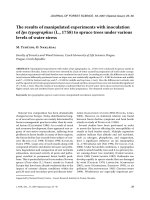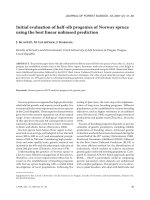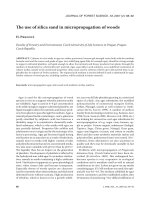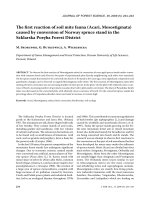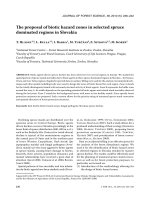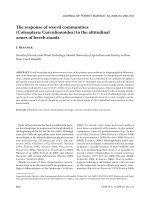Báo cáo lâm nghiệp: "The use of silica sand in micropropagation of woods" pot
Bạn đang xem bản rút gọn của tài liệu. Xem và tải ngay bản đầy đủ của tài liệu tại đây (394.46 KB, 5 trang )
88 J. FOR. SCI., 53, 2007 (2): 88–92
JOURNAL OF FOREST SCIENCE, 53, 2007 (2): 88–92
Agar is used for the micropropagation of wood
species in vitro as a support whereby nutrient media
are solidified. Agar is used in 6–8 g/l concentration
to be solid enough to support cultivated plantlets, yet
liquid enough to allow the nutrients and drossy prod-
ucts from plants to pass through the medium. Agar, a
natural polysaccharide containing - and -galactose
partly esterified by sulphuric acid, has however a
disability range. It is considered a chemically unde-
fined substance, which is why media with agar are
just partially defined. Properties like solidity and
adulterants vary in origin and by the technique of its
factory processing. Agar gel becomes liquid during
sterilization in an autoclave as a result of hydrolysis,
namely more in media with higher content of salts
and phytohormones than in less concentrated media.
It is also more unstable with pH 4.5 than by pH 5.7.
e liquidity then has an impact on the generation
of plantlets. Development of plantlets is affected by
the hydrolyzed non-solid agar. It can induce vitrifica-
tion, namely in media containing a high cytokinine
level. Vitrification is apparent as a poor physiological
state, when tissues fade and become transparent.
Especially shoots of woody species are character-
ized by extremely short internodiums and thickened
deformed leaves without cuticula. High production
of ethylene, which is known to be a growth inhibi-
tor, can even kill the plantlets growing in a restricted
space of a flask. Any agar substitutes, the modified
polysaccharides of commercial marques Gerlite,
Gellan, Phytagel, mostly as well conduce to vitrifi-
cation (K, K 1999). A number of authors
mainly from developing countries (e.g. B, J
1998; N, S 2001; M et al. 2004, etc.)
are looking for various low-cost agar substitutes for
micropropagation of e.g. sugar cane, banana, ap-
ple or potato. Various organic substances (Isubgol,
Tapioca, Sago, China grass, Natugel, Guar gum,
sugar cane bagasse, coconut, and cotton or muslin
fibre) and also some synthetic materials (nylon and
polyester fibre, polystyrene foam) were tested. Nev-
ertheless, these alternatives are also uncertain in
quality and they may be chemically unstable in hot
acid solutions.
Problems with micropropagation of Pinguicula
bohemica Kraj. (Czech butterwort) have been de-
scribed (S 1989). is endangered her-
baceous species is very responsive to ecological
conditions and it manifests itself as well in natural
conditions as in vitro. It does not grow on any media
containing agar. If ½ MS medium was used, the opti-
mal pH was 4.8–4.9. e medium solidified by agar
lost its consistency and the established acidity after
20 minutes of autoclaving. Very difficult diffusion of
e use of silica sand in micropropagation of woods
H. P
Faculty of Forestry and Environment, Czech University of Life Sciences in Prague, Prague,
Czech Republic
ABSTRACT: Cultures in vitro made in agar are rather precarious, because gel strength varies both with the medium
formula used and the source and grade of agar. Any solidifying agent (like for example agar) should be strong enough
to support cultivated plantlets, yet liquid enough to allow the nutrients and drossy products from plants through the
medium. It should also be a chemically inert material. Agar, especially in acid solutions, is an undefined constituent of
culture media, namely in the mentioned properties. Silica sand, used in cultures of herbs up to the present time, is ap-
plicable also in cultures of Sorbus sudetica. e required acid medium is exactly defined if sand is substituted for agar.
Similar cultures of wood species, including conifers, will be realized in future research.
Keywords: micropropagation; agar; silica sand; acid medium; Sorbus sudetica
J. FOR. SCI., 53, 2007 (2): 88–92 89
abscisic acid, an inhibitor produced by old leaves of
plantlets, probably also presented a negative influ-
ence in agar medium. Another limiting factor playing
a role in cultures of P. bohemica was overly restricted
surface contact between the plantlets and the plus
minus solid agar medium. at was the reason why
a support by bath-shaped paper set in a liquid me-
dium was also unsuitable. Sand was found to be the
only beneficial support in the described special case,
being chemically inert, adequately solid and perfect
for diffusion of soluble substances. White silica sand
marked PR 21 from the sandpit Provodín near Česká
Lípa () was used in laboratories
of the North-Bohemian Museum in Liberec and later
also of the Botanic Gardens in Liberec.
I consider the following properties as the principal
advantages of the described solution:
1. It is very easy and safe to pour sand and cold liquid
into flasks. e laboratory preparation is better
from this point of view in comparison with risky
manipulation with hot viscid agar solution.
2. A sloping wet surface for plantlets may be easily
created within a flask by means of shaking with
the mixture of sand and a liquid medium.
3. Plantlets can sink into sand partly and contact
with medium is ideal.
4. Acidity stays at the same pH after autoclaving and
no poisonous sulphuric ions occur in the flask.
5. Sand cannot absorb or adsorb any organic sub-
stances. Toxic or inhibiting products are washed
from plantlets, if the flask content is briefly shaken.
6. It is very easy to remove sand from flasks after
culture is finished.
7. Sand is a cheap material and is delivered in a de
-
fined quality.
ese advantages were the base for my research
into how to apply a similar method in Sorbus su-
detica Tausch (P 2004). It should be em-
phasized that woody species are more difficult than
herbs in cultures in vitro, and conifers are especially
more difficult than deciduous wood species (K,
K 1999). Selected results gained using Sorbus
are briefly presented here, because research of an-
other woody species should be derived from this
experience and used in my future thesis.
MATERIAL AND METHODS
ree specimens used as a resource of seeds are
cultivated in Botanic Gardens of Liberec. ey were
transferred to the Gardens from a Genetical Bank
of the Krkonoše National Park as seedlings in 1994.
From genetic viewpoint, the species is a tetraploid
(2n = 68) known as an apomictic wood. Its very
restricted endemic population is bound to very spe-
cial habitats in Krkonoše Mts. (Giant Mountains) in
Bohemia (K, Š 1986; K
2000). We can conclude from these facts that all
material useful to micropropagation should be con-
sidered as a sole mother clone.
Comparing cultures in sand and in agar
A medium of ½ RM-1964 with a content of 0.4 mg
BAP, pH 5.8, was manufactured. is medium was
used in part as liquid with sand (25 cm
3
sand + 20 ml
solution), in part reinforced by heating 6g of agar in a
1 l medium. Cultures were incubated for 6 weeks with
a daily lighting period of 14 hours. After completion
of the cultures, for orientation, pH was established
3 times for each series with liquid media and with agar
(by dripping liquid pH indicator for aquaristics).
Each culture was evaluated with the help of a mul-
tiplication coefficient, established as the number of
viable segments acquired from the original during
the incubation period. Contaminated cultures were
not counted. Data were statistics evaluated by test-
ing a zero hypotheses for the conformity of selection
averages for liquid and reinforced media (t-test from
Excel computer program tools).
Findings of the pH impact of nutrient media
A medium of ½ RM-1964 was prepared with or-
ganic substances like in the previous case, containing
0.4 mg BAP/l. e bearer was sand (25 cm
3
sand +
20 ml medium). e finished medium was divided
into 3 parts and dripped at each 1N NaOH or 1N HCl
set for a different acidity: pH 6.6; pH 5.6; pH 4.5 (es-
tablished by colour indicator Serra-test for aquaris-
tics). Incubation was conducted by the method noted
in the previous case.
An evaluation was also conducted according to the
multiplication coefficient. With the help of a t-test, first
the zero hypothesis was tested – that the average for cul-
tures with pH increased against the standard pH of 5.6
does not differ from the average for cultures with a pH of
5.6. By the same method, the zero hypothesis was tested
for conformity of averages for pH 5.6 and pH 4.5.
RESULTS
Comparing cultures in sand and in agar
After the completion of cultivation, it was de-
termined that when using sand, the starting pH of
5.8 remained essentially unchanged (final pH 5.6).
Media reinforced by agar, however, were acidified so
90 J. FOR. SCI., 53, 2007 (2): 88–92
much that a pH of 4.5 was achieved or exceeded to
the edge of measurement. At the same time, it was
observed, that after autoclaving agar in flasks was
at various degrees of liquidity. is was apparently
interrupted by hydrolysis.
Methods for propagation were compared statisti-
cally and an evidential difference was determined
among the mean values of the multiplication coef-
ficient. e diffusion of values also significantly dif-
fers (Fig. 1). In agar reinforced media it is possible to
achieve very good growth. Overall, their utility for
experiments also for practical production purposes is
burdened by the fact that they are undefined or only
partially defined. is observation from the literature
(K, K 1999) was also confirmed during the
experiment. In the case of the species Sorbus su-
detica, growth could be favourably influenced by the
actual determination of the acidic environment dur-
ing the hydrolysis of agar. e following experiment
originated from these possibilities and conjectures.
Determining the impact of pH on nutrient media
pH 4.5, total of 45 flasks: 1 × 7 specimens, 3 × 6
specimens, 5 × 5 specimens, 14 × 4 specimens, 14 ×
3 specimens, 5 × 2 specimens, 2 × 1 specimens, 1 ×
0 specimen (i.e. non-growth + apparent senescence)
– average 3.56.
pH 5.6, total of 33 flasks: 1 × 5 specimens, 4 × 4
specimens, 6 × 3 specimens, 12 × 2 specimens, 6 × 1
specimen, 4 × 0 – average 2.09.
pH 6.6, total of 35 flasks: 1 × 5 specimens, 3 × 3
specimens, 11 × 2 specimens, 14 × 1 specimen, 6 × 0
– average 1.43.
The graphic expression of results of statistical
evaluation, including reliability intervals, appa-
rently demonstrates the most acidic environment as
the most beneficial (Fig. 2). A medium with pH 4.5,
however, due to the hydrolysis adjustment, cannot
reinforce agar and the use of sand becomes neces-
sary.
Any statistical judges cannot bear more witness in
the matter of Sorbus sudetica qualities, because it is
a species with a very homogenous population with
extremely low genetic diversity. So results of experi-
ments are adequate to the entire species.
DISCUSSION
In natural conditions Sorbus sudetica is no ob-
ligatory acidophyte (K, Š 1986).
Contrary to this, under artificial conditions in vitro,
0
2
4
6
8
10
12
14
0 1 2 3 4 5 6 7 8 9 10 11 12 13 14 15 16 17 18 19 20
Multiplication coefficient
Frequency
agar
písek
Fig. 1. Propagation of Sorbus sudetica in
a medium with agar and or with sand,
expressed by means of a multiplication
coefficient
0,0
0,5
1,0
1,5
2,0
2,5
3,0
3,5
4,0
4,5
4,5 5,6 6,6
pH
Avg. multiplication
(with reliability interval)
Fig. 2. Propagation of Sorbus sudetica in vitro
using media differing in acidity
4.5
4.0
3.5
3.0
2.5
2.0
1.5
1.0
0.5
0.0
4.5 5.6 6.6
sand
J. FOR. SCI., 53, 2007 (2): 88–92 91
according to the presented results an acidic medium
is very favourable. Lower pH in comparison with
original formula of culture medium was successfully
examined by other authors also in Rhododendrons
etc. (K, K 1999).
Paradoxically, in agar media it grows best if there is
manifest attenuation and acidification as a result of
hydrolysis of the agar. Overall, the degree of hydroly-
sis of agar and the characteristics of the media after
sterilization in an autoclave cannot be anticipated.
Microbiologists state directly that agar media with
the pH of 4.5 needed for Sorbus sudetica cannot be
completely sterilized in an autoclave (K et
al. 1967). Logically, we have come to the conclusion
that chemically stable siliceous sand with numerous
advantages could be an aid to resolving some diffi-
culties with cultures of woody species in vitro. Initial
experiments, though incomplete to publication, are
indicating this possibility (Fig. 3).
Silica sand is applicable to future experiments
with all wood species as an alternative for agar. New
possibilities open by experiments with silica sand
plus liquid mediums with low pH have a use to the
laboratory Truba Breeding Station of the Forestry
Research Institute in Kostelec nad Černými lesy.
Low pH and high levels of phytohormones can bear
interesting results by cultures in vitro, especially in
somatic embryogenesis of Abies hybrids and Ulmus
glabra. I suppose even improvement of the necessary
dessication of somatic embrya if slightly wet silica
sand will be replaced for paper used by authors up to
now. Organogenesis of Prunus avium is also a job of
the mentioned laboratory. e described advantages
will help also in this species probably.
R e feren c es
BABBAR S.B., JAIN N., 1998.
´Isubgol´as an alternative gel-
ling agent in plant tissue culture media. Plant Cell Reports,
17: 318–322.
KAPRÁLEK F., KOUTECKÁ E., ZÁVADA V., 1967.
Mikro-
biologické praktikum. Praha, PřF UK: 38.
KOCIÁNOVÁ M., ŠTURSOVÁ H., 1986.
Revize rozšíření
a ekologie jeřábu krkonošského (Sorbus sudetica). Opera
Corcontica, 23: 77–100.
KOVANDA M., 2000.
Jeřáby v Praze. Živa, 48: 12–13.
KYTE L., KLEYN J., 1999.
Plants from Test Tubes. 3
rd
ed.
Portland, Timber Press: 240.
MOHAN R., SOCCOL C.R., QUOIRIN M., PANDEY A.,
2004. Use of sugarcane bagasse as an alternative low-cost
support material during the rooting stage of apple micro-
propagation. In vitro Cellular and Developmental Biology
– Plant, 40: 408–411.
NAIK P.S., SARKAR D., 2001.
Sago: an alternative cheap gel-
ling agent for potato in vitro culture. Biologia Plantarum,
44: 293–296.
PRKNOVÁ H., 2004.
Optimalizace kultivačních podmínek
při mikropropagaci jeřábu krkonošského (Sorbus su-
detica) pro účely záchrany fytogenofondu v imisní oblasti
Krkonošského národního parku. [Diplomová práce.] Praha,
ČZU, FLE: 56.
STUDNIČKA M., 1989.
Studie kriticky ohroženého druhu
Pinguicula bohemica se zřetelem na možnosti jeho záchra-
ny. [Kandidátská dizertační práce.] Průhonice, Botanický
ústav AV ČR: 185.
Received for publication July 18, 2006
Accepted after corrections September 18, 2006
Fig. 3. Successful culture of embryogenic tissue of Abies alba
in an acid SH medium plus silica sand
Použití křemičitého písku při mikropropagaci dřevin
ABSTRAKT: Kultury in vitro za použití agaru jsou poněkud nejisté, protože pevnost gelu se různí podle složení
média i zdroje a kvality agaru. Každé zpevňovací činidlo (např. agar) by mělo být dostatečně pevné na to, aby rostlinky
udrželo, ale dostatečně tekuté, aby dovolovalo přístup k živinám a umožňovalo pronikání odpadních produktů od
rostlin. Mělo by také být chemicky inertní. Agar je v těchto vlastnostech nedefinovanou složkou kultivačních médií,
92 J. FOR. SCI., 53, 2007 (2): 88–92
Corresponding author:
Ing. H P, Česká zemědělská univerzita v Praze, Fakulta lesnická a environmentální, katedra dendrologie
a šlechtění lesních dřevin, 165 21 Praha 6-Suchdol, Česká republika
tel.: + 420 321 697 201, fax: + 420 234 381 860, e-mail:
obzvláště v kyselých roztocích. Křemičitý písek, dosud používaný při kulturách bylin, je vhodný i pro kultury Sorbus
sudetica. Potřebné kyselé médium je přesně definované, pokud je agar nahrazen pískem. Podobné kultury dřevin
(včetně jehličnanů) jsou předmětem dalšího výzkumu.
Klíčová slova: mikropropagace; agar; křemičitý písek; kyselé médium; Sorbus sudetica
